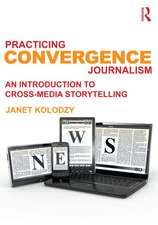White News: Why Local News Programs Don't Cover People of Color: Routledge Communication Series
Autor Don Heideren Limba Engleză Paperback – noi 2000
Heider examines the perceptions of racism and ethnicity, and addresses such dichotomies as "white" news (content determined by white managers) being delivered by non-white news anchors, thus giving the appearance of "non-white" news. He also considers how coverage of minorities influences viewers' perceptions of their minority neighbors. Heider then sets forth a new theoretical concept--incognizant racism--as a way of explaining how news workers consistently ignore news in significant portions of the communities they cover.
This contribution to the minorities and media discussion provides important insights into the newsroom decision-making process and the sociology and structure of newsrooms. It is required reading for all who are involved in news reporting, mass communication, media and minority studies, and cultural issues in today's society.
Din seria Routledge Communication Series
- 9%
 Preț: 575.55 lei
Preț: 575.55 lei - 9%
 Preț: 576.44 lei
Preț: 576.44 lei -
 Preț: 155.44 lei
Preț: 155.44 lei - 8%
 Preț: 495.23 lei
Preț: 495.23 lei - 8%
 Preț: 417.13 lei
Preț: 417.13 lei - 15%
 Preț: 404.22 lei
Preț: 404.22 lei -
 Preț: 392.97 lei
Preț: 392.97 lei - 8%
 Preț: 516.78 lei
Preț: 516.78 lei -
 Preț: 171.85 lei
Preț: 171.85 lei - 8%
 Preț: 509.91 lei
Preț: 509.91 lei - 8%
 Preț: 460.12 lei
Preț: 460.12 lei - 8%
 Preț: 394.36 lei
Preț: 394.36 lei -
 Preț: 424.75 lei
Preț: 424.75 lei - 15%
 Preț: 431.10 lei
Preț: 431.10 lei -
 Preț: 364.94 lei
Preț: 364.94 lei -
 Preț: 363.96 lei
Preț: 363.96 lei - 22%
 Preț: 325.34 lei
Preț: 325.34 lei - 15%
 Preț: 463.49 lei
Preț: 463.49 lei - 15%
 Preț: 467.42 lei
Preț: 467.42 lei -
 Preț: 366.85 lei
Preț: 366.85 lei -
 Preț: 264.53 lei
Preț: 264.53 lei - 16%
 Preț: 247.75 lei
Preț: 247.75 lei -
 Preț: 354.28 lei
Preț: 354.28 lei -
 Preț: 374.27 lei
Preț: 374.27 lei - 22%
 Preț: 321.54 lei
Preț: 321.54 lei -
 Preț: 421.07 lei
Preț: 421.07 lei -
 Preț: 481.52 lei
Preț: 481.52 lei -
 Preț: 442.50 lei
Preț: 442.50 lei -
 Preț: 498.91 lei
Preț: 498.91 lei -
 Preț: 369.95 lei
Preț: 369.95 lei - 24%
 Preț: 133.28 lei
Preț: 133.28 lei - 31%
 Preț: 325.43 lei
Preț: 325.43 lei - 25%
 Preț: 769.37 lei
Preț: 769.37 lei -
 Preț: 447.05 lei
Preț: 447.05 lei - 18%
 Preț: 722.88 lei
Preț: 722.88 lei -
 Preț: 389.60 lei
Preț: 389.60 lei -
 Preț: 249.75 lei
Preț: 249.75 lei -
 Preț: 395.37 lei
Preț: 395.37 lei -
 Preț: 363.96 lei
Preț: 363.96 lei - 18%
 Preț: 1004.72 lei
Preț: 1004.72 lei - 18%
 Preț: 998.71 lei
Preț: 998.71 lei -
 Preț: 380.22 lei
Preț: 380.22 lei - 26%
 Preț: 243.26 lei
Preț: 243.26 lei -
 Preț: 102.17 lei
Preț: 102.17 lei -
 Preț: 242.11 lei
Preț: 242.11 lei - 20%
 Preț: 402.68 lei
Preț: 402.68 lei -
 Preț: 226.33 lei
Preț: 226.33 lei -
 Preț: 386.14 lei
Preț: 386.14 lei -
 Preț: 241.09 lei
Preț: 241.09 lei - 18%
 Preț: 961.37 lei
Preț: 961.37 lei
Preț: 338.00 lei
Nou
Puncte Express: 507
Preț estimativ în valută:
64.68€ • 69.16$ • 53.93£
64.68€ • 69.16$ • 53.93£
Carte tipărită la comandă
Livrare economică 17 aprilie-01 mai
Preluare comenzi: 021 569.72.76
Specificații
ISBN-13: 9780805839562
ISBN-10: 0805839569
Pagini: 126
Dimensiuni: 152 x 229 x 9 mm
Greutate: 0.18 kg
Ediția:New.
Editura: Taylor & Francis
Colecția Routledge
Seria Routledge Communication Series
Locul publicării:Oxford, United Kingdom
ISBN-10: 0805839569
Pagini: 126
Dimensiuni: 152 x 229 x 9 mm
Greutate: 0.18 kg
Ediția:New.
Editura: Taylor & Francis
Colecția Routledge
Seria Routledge Communication Series
Locul publicării:Oxford, United Kingdom
Public țintă
ProfessionalCuprins
Contents: Introduction. News Power. News Coverage. Access. Geography and News. History and News. Conclusion. Possible Remedies. Appendix: Detailed Methodology.
Recenzii
"The book belongs on the bookshelf of any and all who care about the growing racial diversity of our country and what the news media need to do to more accurately report news from non-White communities."
—Journalism & Mass Communication Quarterly
"White News should be required reading for both broadcast and print journalists. Moreover, it should be taken as a lesson for news managers to better their coverage not only for ethical reasons, but for economic ones."
—News Watch
"Heider's White News presents an innovative approach to the issue of documenting racial bias in news reports: an ethnographic study of benefit to both graduate and undergraduate students. This book would be an excellent source for educators and graduate students because it describes in detail and in a simple manner the qualitative methodology (participant observation) used in the study, included as an appendix which should be read first. In addition, it would provide a rich arena for the introduction and discussion of hegemonic theory and how it could be applied to news coverage."
—Journalism & Mass Communication Educator
"Well researched and written, Heider offers remedies for the present pale situation."
—Journal of Mass Media Ethics
"...Heider has written a concise, widely accessible volume....I am pleased with the humanity so intricately woven into the fabric of this book. Every paragraph and every chapter introduces the texture of lived experiences as well as common local and national perceptions....Congratulations to Heider for a book that may very well introduce to the discipline a different way to talk about local news coverage."
—Communication Theory
"It's an important work and well-told. I am afraid it made me even more pessimistic about the state of local news."
"Professor Don Heider is able to offer the unique perspective of a news professional and an educator. Heider's more than 10 years as a broadcast journalist gives him a distinctive insight into the thoughts, motivations, and priorities of news workers. Familiarity with the newsroom culture allowed Professor Heider to gain the trust of journalists in two newsrooms. The responses of the news professionals in those newsrooms to Heider's queries regarding coverage of communities of color add several intriguing layers to his study. This is a superlative look at the grievous coverage, or lack of coverage, given communities of color by local newscasters. Professor Heider takes the issue even further by offering solid, common sense solutions to this ever growing problem."
—Marty Gonzalez
San Francisco State University/Weekend morning anchor, KRON-TV, San Francisco
"White News takes the reader into the nitty-gritty of television news production, explaining along the way the numerous turn of events that contribute to the limited and negative coverage of people of color. It is insightful, precise, yet very clear in its language and examples used to support the critique of such coverage. Most importantly, the book is both well documented in the analysis of the problems, and solid in the solutions offered to overcome such limited coverage. Given such scope, White News is most valuable for educators, journalism students, as well as media professionals--including the television station owners and news managers who ultimately have the first and last word on how the TV news rooms are run. White News is a must read for those in the profession teaching, conducting research, or participating in any form or fashion in the discussion of how media cover ethnic minority populations and society at large."
—Federico Subervi, PhD
Department of Radio-TV-Film, University of Texas at Austin
—Journalism & Mass Communication Quarterly
"White News should be required reading for both broadcast and print journalists. Moreover, it should be taken as a lesson for news managers to better their coverage not only for ethical reasons, but for economic ones."
—News Watch
"Heider's White News presents an innovative approach to the issue of documenting racial bias in news reports: an ethnographic study of benefit to both graduate and undergraduate students. This book would be an excellent source for educators and graduate students because it describes in detail and in a simple manner the qualitative methodology (participant observation) used in the study, included as an appendix which should be read first. In addition, it would provide a rich arena for the introduction and discussion of hegemonic theory and how it could be applied to news coverage."
—Journalism & Mass Communication Educator
"Well researched and written, Heider offers remedies for the present pale situation."
—Journal of Mass Media Ethics
"...Heider has written a concise, widely accessible volume....I am pleased with the humanity so intricately woven into the fabric of this book. Every paragraph and every chapter introduces the texture of lived experiences as well as common local and national perceptions....Congratulations to Heider for a book that may very well introduce to the discipline a different way to talk about local news coverage."
—Communication Theory
"It's an important work and well-told. I am afraid it made me even more pessimistic about the state of local news."
"Professor Don Heider is able to offer the unique perspective of a news professional and an educator. Heider's more than 10 years as a broadcast journalist gives him a distinctive insight into the thoughts, motivations, and priorities of news workers. Familiarity with the newsroom culture allowed Professor Heider to gain the trust of journalists in two newsrooms. The responses of the news professionals in those newsrooms to Heider's queries regarding coverage of communities of color add several intriguing layers to his study. This is a superlative look at the grievous coverage, or lack of coverage, given communities of color by local newscasters. Professor Heider takes the issue even further by offering solid, common sense solutions to this ever growing problem."
—Marty Gonzalez
San Francisco State University/Weekend morning anchor, KRON-TV, San Francisco
"White News takes the reader into the nitty-gritty of television news production, explaining along the way the numerous turn of events that contribute to the limited and negative coverage of people of color. It is insightful, precise, yet very clear in its language and examples used to support the critique of such coverage. Most importantly, the book is both well documented in the analysis of the problems, and solid in the solutions offered to overcome such limited coverage. Given such scope, White News is most valuable for educators, journalism students, as well as media professionals--including the television station owners and news managers who ultimately have the first and last word on how the TV news rooms are run. White News is a must read for those in the profession teaching, conducting research, or participating in any form or fashion in the discussion of how media cover ethnic minority populations and society at large."
—Federico Subervi, PhD
Department of Radio-TV-Film, University of Texas at Austin
Descriere
This volume explores the coverage of minority populations in local news, for scholars and students in media studies, race and media, and print and broadcast journalism.























